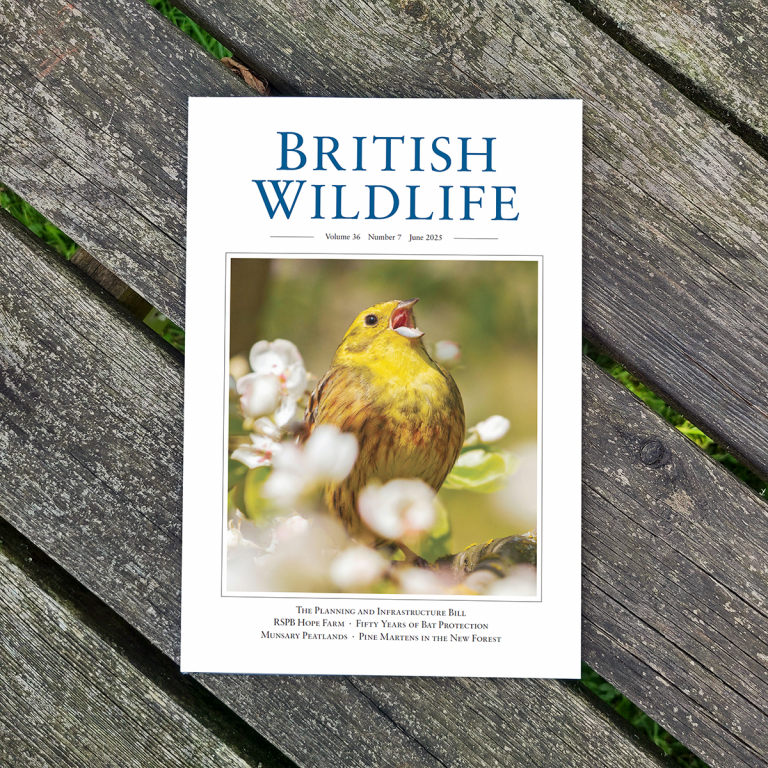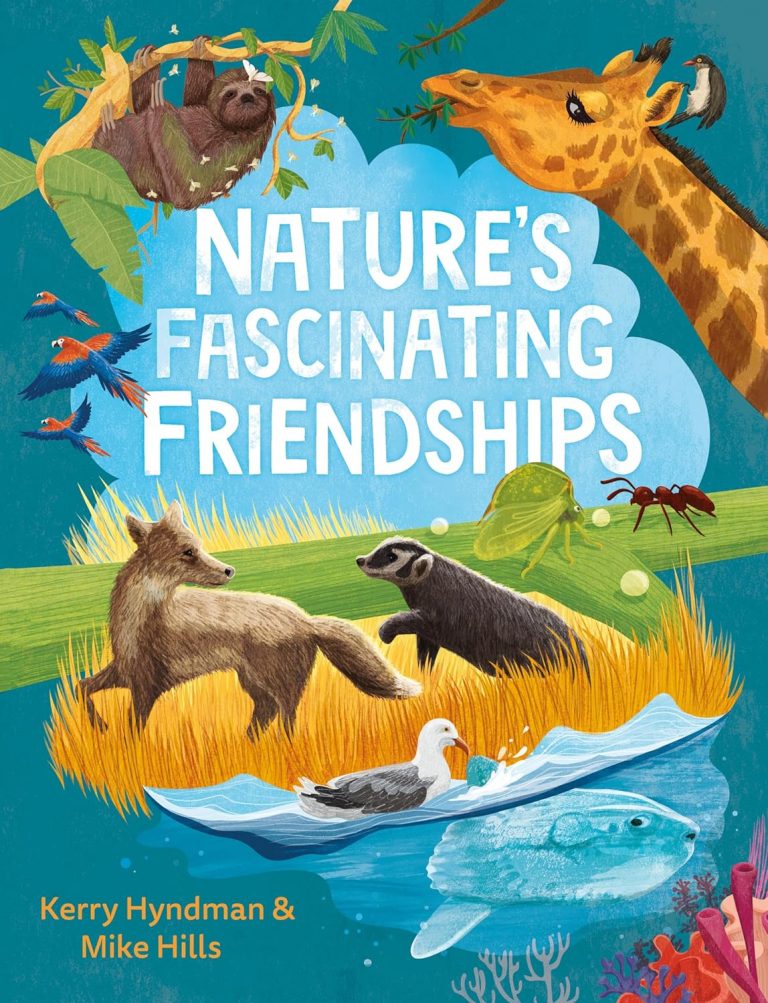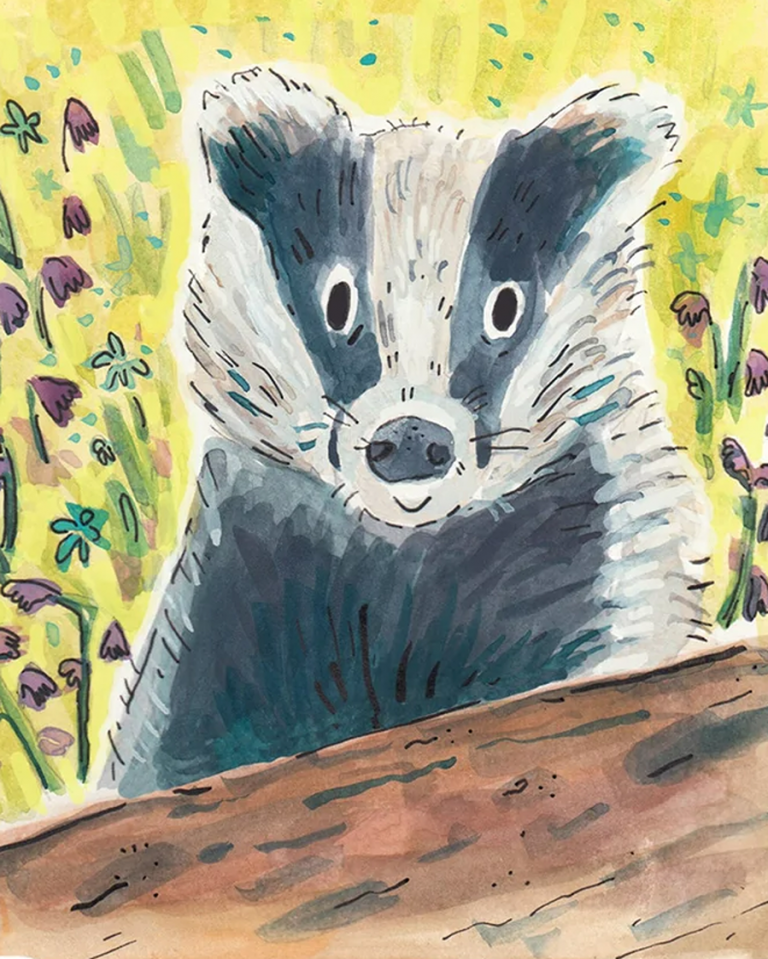
Peat compost has been a staple in gardens for decades, but it’s time to take a closer look at what it really costs. While it’s cheap and easy to find, using peat compost can do a lot more harm than good.
Keep fresh compost away from pets, as it contains mould. Also keep cocoa, pine and rubber mulch away from pets. Also read our post on making garden compost.
England has lost half its peat bogs. Our peatlands are home to 5000 species of insect and supply most of our drinking water.
Gardener Monty Don calls using peat ‘eco-vandalism’ (even today, some organic box schemes use peat to grow lettuce, and most garden centres sell it).
He wants the government to ban its sale, to protect curlews, golden plovers, hen harriers, amphibians and reptiles.
Peat Extraction Causes Floods
When companies dig up peat bogs, they strip away natural defences that hold rainwater in place. Peatlands store huge amounts of water and help stop sudden run-off after heavy rain.
Once these bogs are damaged, water rushes into streams and rivers much faster. This can lead to flooding downstream, washing away homes, roads, and farmland. The damage is long-lasting, and it’s hard for bogs to recover.
Loss of Habitat for Endangered Species
Peat bogs support rare plants, birds, and insects you won’t find anywhere else. Many of these species are endangered and rely on healthy wetlands to survive. When peat is removed, their homes vanish.
Birds like the curlew, plants like the bog rosemary, and many insects are pushed closer to extinction. The loss can be permanent, and the damage spreads through the food chain.
Releases Locked-Down Carbon
Peatlands act as giant carbon sinks. They hold more carbon than forests per square metre because the moss and plants don’t fully break down in the soggy soil. Digging up peat to make compost releases that carbon, adding to climate change.
Each bag of peat compost sold means more carbon in the air. This makes global warming worse and undoes years of efforts to cut emissions.
Peat Bogs Take Thousands of Years to Form
Peat builds up at a snail’s pace, sometimes just a millimetre a year. What you buy in a bag took centuries, even millennia, to form.
Once gone, it won’t come back quickly. That means using peat compost destroys something that can’t be replaced within our lifetime.
Protects Water Quality
When peat bogs are dug out, they can leak nutrients and sediments into streams and rivers. This pollution makes it harder for fish and water insects to thrive.
Clean, healthy rivers are good for wildlife and people. Using peat-free compost helps keep our waterways clearer and healthier for all.
Supports Local Jobs and Sustainable Practices
Many peat-free composts are made from local materials like green waste and wood. Choosing these helps local businesses and cuts down on transport. It also supports a shift to sustainable, earth-friendly gardening.
When gardeners choose these options, it encourages more green jobs and less reliance on damaging industries.
Good Alternative to Peat Compost
- Natura Grow offers organic compost made from energy crops, on a Cambridgeshire farm, which are fed into anaerobic digestors (to supply energy). Buy as liquid feed or pellets, that are added to soil.
- Some composts are made from coir (a by-product of processing coconuts) and others use bracken. Two good brands are Natural Grower (which also offers a liquid fertiliser to pour around the base of plants). And Fertile Fibre (multipurpose, seed or potting compost)
- B & Q now sells own-brand peat-free compost, and commits to going peat-free by 2026. But why wait until then?
Plant Fertiliser (from waste seaweed)
Shock Shot Seaweed Fertiliser is made from waste seaweed, a better idea than fishmeal or bonemeal, which is unkind and can attract vermin.
This fertiliser is a nutrient boost to your plants. Just mix with water and see them thrive. Bring plants back to life. Just add to at least 1 litre of water in your watering can, to heal drooping leaves, slow growth or a tired appearance. The concentrated seaweed can enhance root health and promote vibrant growth.
Never harvest seaweed yourself, leave it to experts to ‘give seaweed a haircut’ but not remove the roots. Don’t let dogs play with seaweed, it expands in the stomach, as it dries.
The Coconut Compost Company (peat-free soil)
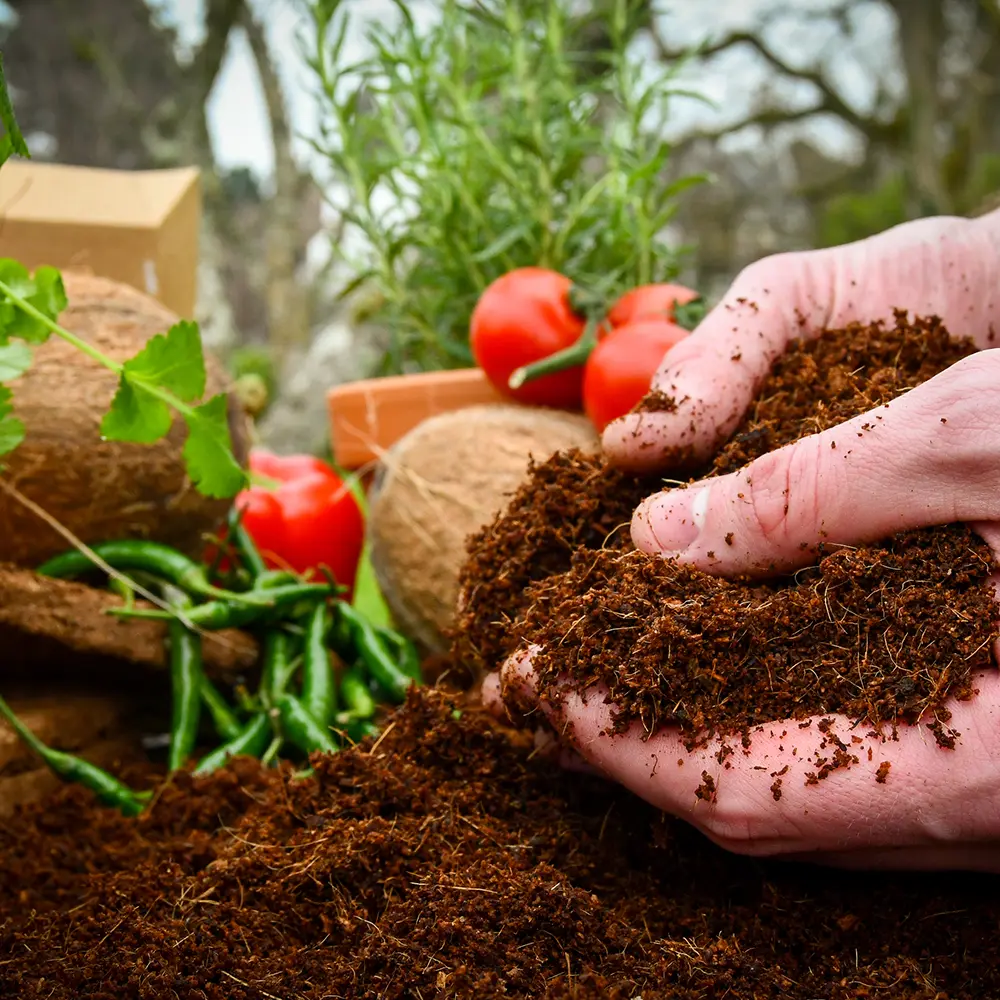
Peat extraction strips ancient bogs, releases stored carbon, and destroys habitats that took centuries to form. Gardeners know this, yet many still reach for peat because it is familiar. There is a cleaner, smarter choice you can use today. The Coconut Compost Company supplies a peat-free soil based on coconut coir, a by-product of the coconut industry, that delivers reliable results without the environmental cost.
Commercial growers have been moving to coir for years, and home gardeners are catching up fast. It is easy to handle, quick to prepare, and kind to roots. This peat-free compost suits herbs, vegetables, houseplants, and seed sowing. It arrives compact, hydrates in minutes, and supports strong growth with sensible watering and feeding.
Use no-dig gardening to protect wildlife, and never use netting to be wildlife-friendly. Also read our post on pet-friendly gardens (some mulches and fresh compost are unsafe near animal friends). For indoor plants, never face plants to outdoor gardens, to help prevent birds flying into windows.
If making your own compost, just bin allium scraps (onion, garlic, leeks, shallots, chives) and rhubarb/citrus scraps, as acids could harm compost creatures. Also don’t compost more than a small amount of coffee/tea grounds due to caffeine (could harm worms in excess – add in shredded cardboard to reduce acids).
Why Choose Coconut Compost?
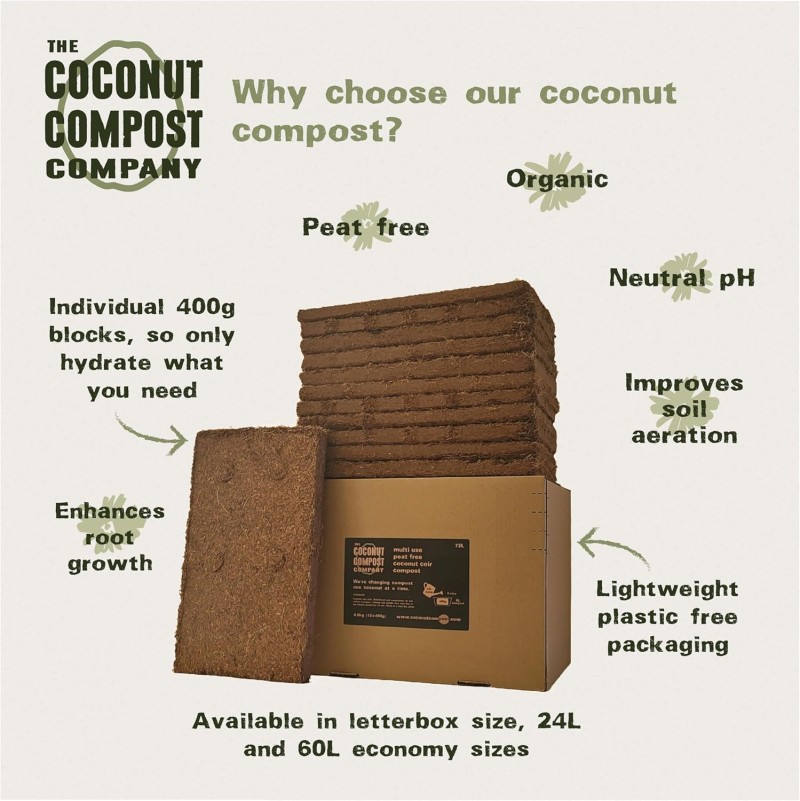
Peat is not renewable in any useful timeline. Bogs store carbon and support rare wildlife, yet mining peat releases that carbon and destroys the habitat. Once gone, it does not recover quickly. That is a high price to pay for potting up tomatoes.
Coconut coir is different. It comes from husks left over from coconut production, so it makes use of a resource that would otherwise be waste. The Coconut Compost Company sources coir from Sri Lanka, treats it to remove excess salts, then compresses it for transport. Shipping compact blocks by sea lowers the carbon per litre of growing medium. For gardeners who care about sustainable gardening compost, this is a clear step forward.
The practical gains are strong as well. Coir has a fibrous structure that lets roots explore. Growers report better root development than with denser peat, which can compact and suffocate young roots. With sensible water management, coir holds moisture while still allowing air to reach the root zone. That balance supports steady growth and reduces issues like root death from waterlogged conditions.
Storage and handling also improve. A compressed brick is light, tidy, and simple to move. You can store a box in a cupboard, carry it to a balcony, or hydrate it at a kitchen sink. Commercial growers talk about affordability and productivity, as well as the reduced haulage and handling time that comes with a compact format. For anyone switching at home, the same perks apply, only the scale is smaller.
Use it across your garden. Herbs, leafy greens, tomatoes, chillies, and houseplants all respond well to coir. Seedlings appreciate the fine, airy texture. With balanced feeding, you will see consistent growth and healthier plants. If you are weighing peat-free soil benefits against effort, coir makes the choice easy.
Environmental and Sustainability Wins
Coconut compost cuts the demand for peat, so bogs stay intact and continue to store carbon. The coir itself uses waste from coconut processing, which reduces pressure on land and materials. The company removes salts during production, which improves plant safety and reduces the need for heavy flushing later. Compression shrinks the transport volume, then sea freight gets it to the UK with a lower footprint than air.
There is also a social side. The Coconut Compost Company pledges 10 percent of its annual profits to charities in Sri Lanka. The team has close links to the country, so buying this compost supports local causes linked to the source. Ethical sourcing sits alongside practical design, and both add up to a cleaner choice for gardeners.
Better Results for Your Plants
Coir is springy and fibrous, so young roots find paths through it. Compared with peat, which can pack down, coir keeps its structure longer. Growers report even nutrient distribution through the whole root zone, which is key for consistent feeding. That even spread helps strawberries, tomatoes, herbs, and flowers push strong roots and sturdy top growth.
For indoor setups, coir pairs well with grow lights. It keeps moisture without turning soggy, which cuts the risk of damping off in seedlings. For outdoor beds and containers, it blends with soil or stands alone in pots, especially when you add a balanced fertiliser. The result is vigorous growth with fewer root issues and better resilience in hot spells.
How to Use The Coconut Compost
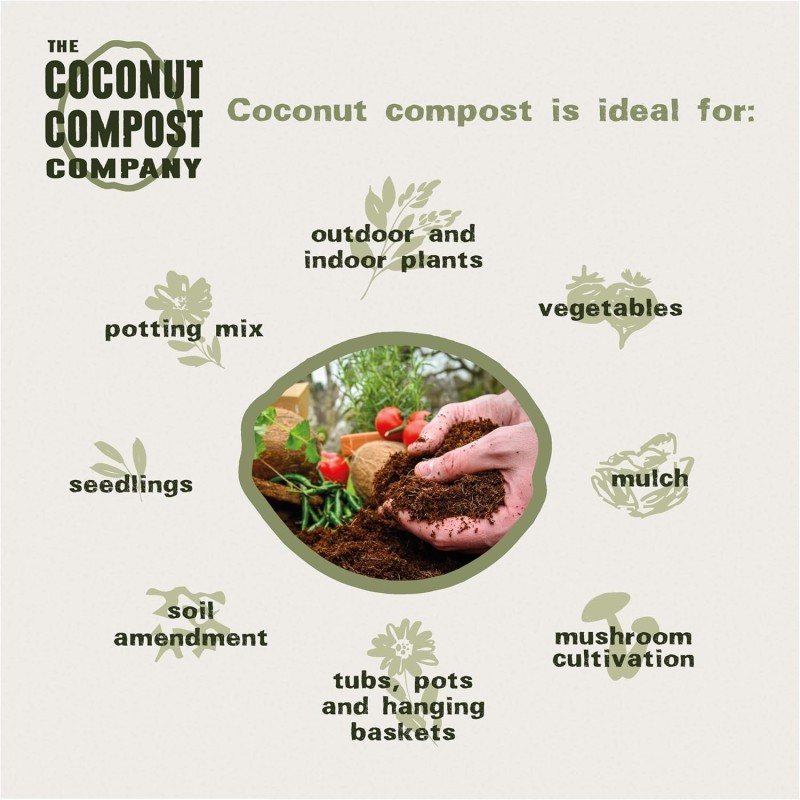
Setup is quick. The parcel is light, clean, and easy to carry. Open the box, place a compressed brick in a bucket, bowl, trug, or wheelbarrow, then add water. The brick swells in minutes and turns into a loose, fluffy medium that is ready to use.
If you are short on space, this is ideal. No heavy bags in the boot, no split sacks, and far less mess. The compact format stores in a cupboard, which suits flat living. It also suits beginners who want a simple peat-free planting guide. Hydrate the brick, work through any clumps with your hands, then pot up seeds, herbs, houseplants, or veg. Add a suitable fertiliser, since coir is low in nutrients by design.
For pots and containers, use it straight or mixed with composted bark or garden soil. For beds, blend it in to improve texture and water management. For seed trays, sieve if you want a finer finish. This easy coconut compost setup removes barriers and gets you growing within the hour.
Step-by-Step Preparation at Home
- Place the coir brick in a sturdy container, such as a bowl, bucket, or wheelbarrow.
- Add the amount of water stated in the instructions. Warm water speeds things up.
- Wait a few minutes while it expands. Have a cup of tea while it does the work.
- Break apart any remaining clumps with your hands or a trowel.
- Check moisture. The texture should be damp and springy, not soggy.
- Add fertiliser, either slow-release granules or a liquid feed, depending on your plan.
- Fill pots, trays, or beds and plant as usual.
Follow the water ratio on the pack. If you add too much, let it drain. If too dry, add a little more. The goal is a light, airy texture that holds together when squeezed, then falls apart when tapped.
Tips for Planting Success
- Vegetables and herbs: Mix coir with a balanced feed and keep moisture steady. Tomatoes and chillies thrive with deep, even watering.
- Houseplants: Use coir for an airy base, then add perlite or bark for extra drainage if needed. Water when the top layer dries.
- Seed sowing: Sieve for a finer top layer. Keep trays moist, not wet, to reduce damping off.
- Indoor growing: Coir works well under grow lights. Herbs set in coir stay tidy and easy to manage in small spaces.
- Feeding: Since coir is low in nutrients, plan a regular feeding schedule. An example is a fortnightly liquid feed for containers.
What Gardeners and Growers Say
Commercial farms have banked on coir for a decade or more. A strawberry grower in Perthshire highlights four wins. The product is affordable, compact, productive, and sustainable. A compact block cuts haulage costs and makes life easier on the farm, while the growing medium holds feed evenly from top to bottom, which drives uniform root growth and strong yields.
Several growers report that peat mixes felt dense and stifled roots. In coir, roots stayed active and spread fast, which reduced dieback and helped plants set fruit earlier. This pattern holds for soft fruit, salads, and greenhouse crops. When water and nutrients stay available through the full depth of the root zone, plants stay stronger for longer.
Home gardeners echo the same themes. A gardener in East Lothian praises the no-fuss setup. No heavy lifting, no spills in the car, and great results for tomatoes and chillies with a simple fertiliser routine. An indoor grower in Edinburgh stores a box in a flat cupboard and uses coir for herbs under a grow light. The herbs kept going month after month, with very little mess to manage.
For seed sowing, users comment on the speed. A warm jug of water, a few minutes of expansion, and the trays are ready. People value how light the brick feels and how clean the process is. From flats to small gardens, the compost fits modern life as well as it fits roots.
Coconut Coir Compost
Coir is the fibrous husks as a by-product of the coconut industry. It’s triple-washed to remove salt and other impurities. It’s the perfect alternative to peat, and lasts three times longer.
Peat-free coconut coir compost has good water retention and good aeration, and helps water drain. Just add warm water, no need to carry heavy bags from the garden centre.
Just place a block in a suitable container, add up to 25 litres of warm water, and wait 20 minutes. The compact block will soak in the warm water, and you can easily break it apart with a garden fork or tool. Join the Peat-Free Loyalty Club to get 10% off purchases.
For houseplants, the compost 1kg brick makes 9 litres of compost, using 3 litres of warm water. The seed and cutting compost has 20% added perlite (volcanic glass) to increase porosity, also making it good for hydroponic growing environments.
Avoid Coco Dots as they are wrapped in non-biodegradable plastic netting.
The Hunting Industry Burns Peat Bogs
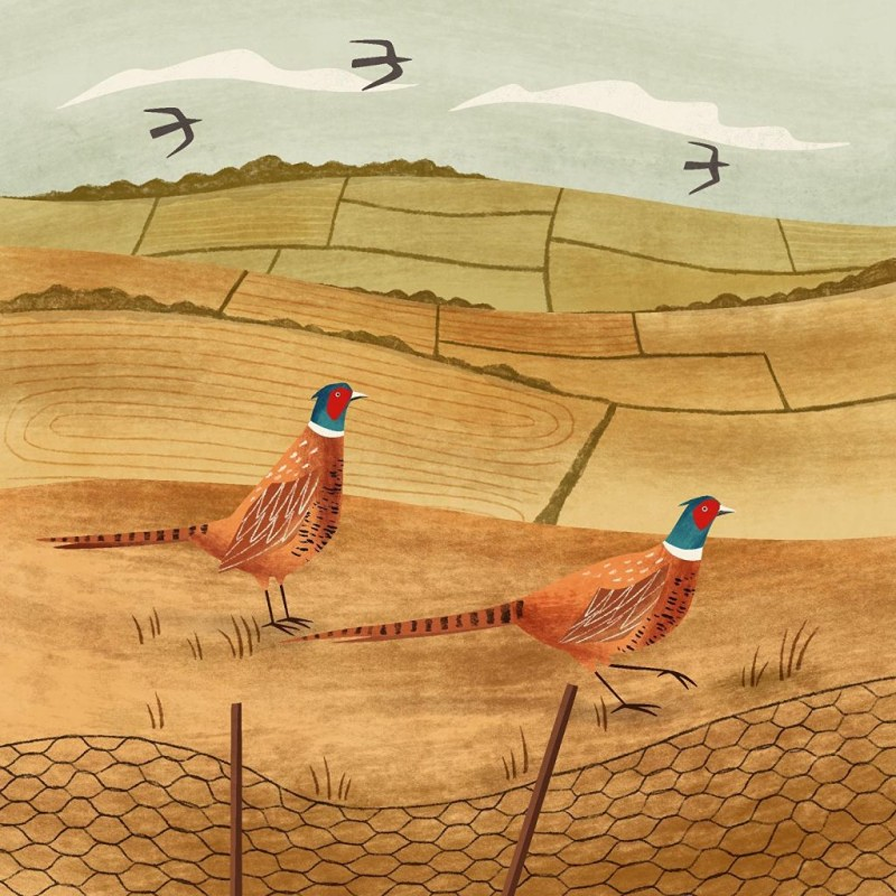
Peat burning often occurs on land used for grouse shoots, by burning vegetation (that lays on top of peat), usually purple moor grass or heather. This provides new heather shoots for grouser (so they are easier to find and shoot).
A voluntary ban by government a few years ago did not work, with Greenpeace reporting fires on peatlands, in northern England’s national parks.
The peat bogs on a grouse shooting estate were on fire. The burning of peatlands is likely to exacerbate floods downstream.
Towns in the Calder Valley such as Todmorden, Hebden Bridge and Mytholmroyd have been flooded repeatedly. George Monbiot
A Book on the Importance of Peat Bogs
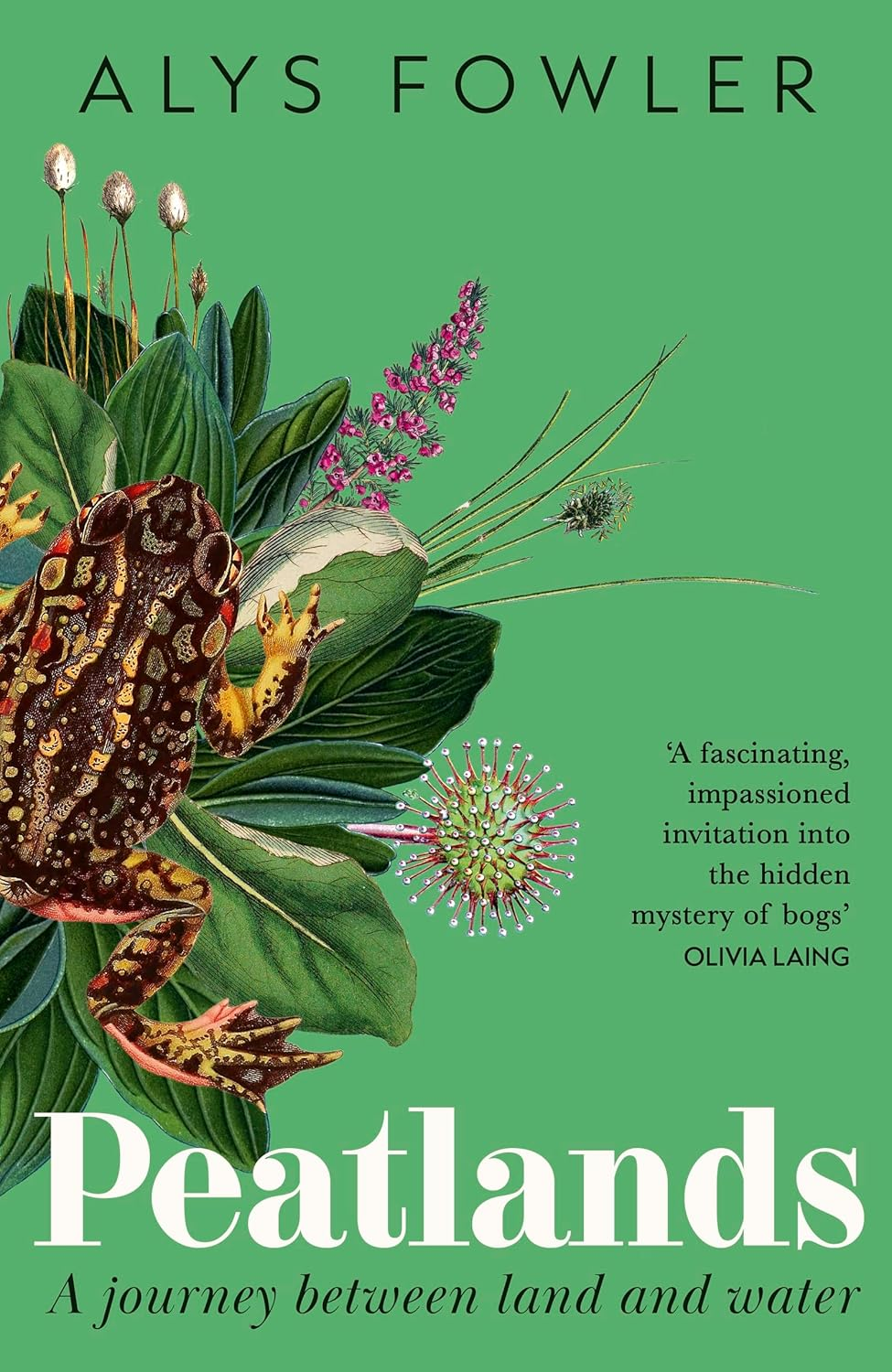
Peatlands is a book on the value of peat bogs by award-winning garden writer Alys Fowler. She calls for us to sink deep into the dark black earths of these rugged places, and take a look at the birds, animals, plants and insects, that live within them.
Living in Wales (nestled between bogs) makes this book both personal and illuminating. Her odyssey takes her from the Peak District to Ireland, creating an intimate picture of these magical places and the people who care.

